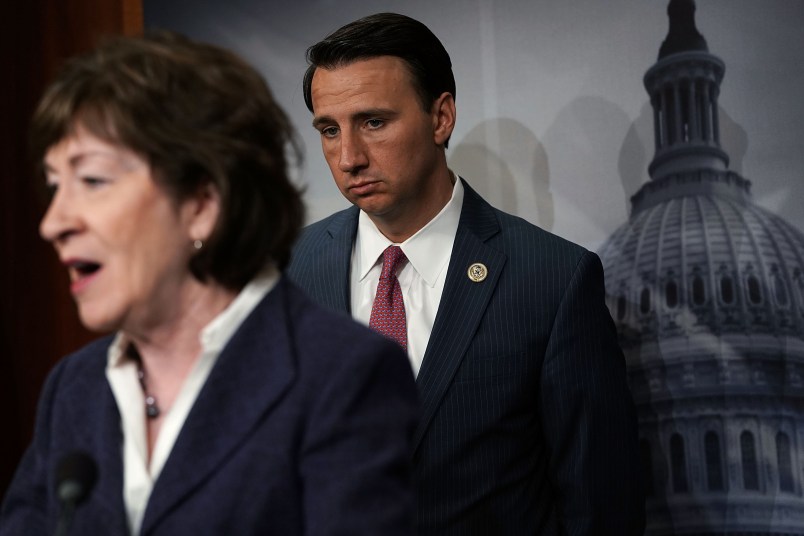With the passage of the budget omnibus, Congress blew past their last, best opportunity to stabilize Obamacare’s struggling individual market and prevent anticipated premium hikes this fall. And, in a bizarre role reversal, it was Senate Republicans who were mad as hell — accusing Democrats of blocking the bill so they could use the rate increases as a political cudgel in this November’s midterm elections.
“I can think of no other explanation,” fumed Sen. Lindsey Graham (R-SC).
Democrats countered by accusing Republicans of putting “poison pills” in the legislation — specifically, provisions expanding a ban on federal funding of abortion into the private insurance market and codifying Trump administration guidance on cheap short-term health insurance Democrats call “junk plans.”
Experts are also dubious that the bill’s core provisions would have lowered premiums as promised, arguing that the policies would have actually made insurance less affordable for many Americans.
Senators have been working across the aisle since last summer to craft policies to shore up the individual market. But the bipartisan efforts were scuttled by GOP leadership, who wanted to spend Congress’ time on unsuccessful bills to repeal Obamacare, and House conservatives, who flatly refused to vote for anything that tacitly even supports the Affordable Care Act. President Trump also sent mixed signals about the legislation, sometimes voicing support and sometimes calling for Congress to let Obamacare “crash and burn.”
Since then, Trump and the GOP-controlled Congress have taken several steps to undermine the ACA market and drive premiums higher: cutting off billions in cost-sharing reduction payments to insurers, cutting the open enrollment window in half, defunding open enrollment outreach, allowing the sale of cheap short-term plans and Association Health Plans that flout ACA regulations, and repealing the individual mandate.
With government score-keepers and independent experts predicting premium increases in the double digits for 2019 — which insurers would announce just before the 2018 midterm elections — lawmakers scrambled to bring their market stabilization bill back to life and stick it in the must-pass budget omnibus. But talks between the two parties broke down in the Senate, lawmakers and aides tell TPM, when President Trump and House Republicans insisted on a provision that would bar any private insurance plan that covers abortion from receiving a federal subsidy.
When Sen. Lamar Alexander (R-TN) attempted to call a vote Thursday evening on adding the ACA rescue package to the omnibus, Sen. Patty Murray (D-WA) objected, and no vote was ever held.
The usually mild-mannered Alexander was furious.
“Let’s don’t make any mistake about who is doing this,” he railed. “Democrats are scrambling and embarrassed, coming up with excuse after excuse. I’m greatly disappointed.”
Murray countered that she was unwilling to “let women’s reproductive freedoms become a political football.”
Contrary to assertions by Alexander and other Republicans that the bill merely included the traditional Hyde amendment language that has blocked federal funding of abortion services since the mid-1970s, Democrats opposed the measure because it would have been a significant and permanent expansion of the restrictions into the private insurance market. Three states, California, New York and Oregon, require nearly all insurance plans cover abortion coverage, meaning no plan in those states could have received a federal subsidy under the GOP plan.
“This partisan bill would take huge steps beyond current law—making it so that women can’t even buy abortion coverage using their own money,” Murray said.
Republicans dismissed these concerns.
“They’re literally making up a phony excuse,” Graham complained on the Senate floor Thursday night. “The other side believes that if they can block this proposal and keep it from becoming law, the premium increases surely to come will fall upon the Republican Party, and will give them the opportunity to take back the House and regain the majority in the Senate. That, to me, is sad.”
“I hope you lose votes,” he told his Democratic colleagues.
Even setting aside Congress’ never-ending abortion battle, Democrats had begun to worry that the plan to restore the CSR subsidies to insurers terminated by Trump and implement a federal reinsurance program might not be the panacea they originally hoped. Cutting the CSR payments last fall led to turmoil in the insurance market that eventually shook out in a way that helped many low-income patients find free or nearly-free insurance plans. Experts fear that sticking them back in now that companies have adjusted to the new normal would raise prices for lower-income people and lead to more people going uninsured.
Additionally, the GOP bill that collapsed had a provision Democrats feared would further codify the cheap short-term health plans newly allowed by the Trump administration that they see as a fundamental threat to the insurance market.
Many health care experts and economists say the sale of these skimpy “junk insurance” plans — which are allowed to charge people more or turn them away based on their age, gender and whether they have a pre-existing condition — will draw younger and healthier people out of Obamacare’s individual market, making the remaining risk pool older, sicker, less stable, and more expensive. A new study by the AARP found that the proliferation of the short-term plans will raise premiums by as much as $4,000 for patients over 60.
Both Democrats and Republicans say they want to keep working on some form of a market stabilization bill, but both sides admit that passing anything out of Congress before they return to the budget showdown game in September will be near impossible.










